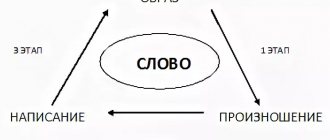Hello dear readers! Lyudmila Redkina is in touch. We continue to explore the depths of human psychology. And on our agenda we have a super topic that is useful for all people! Do you know anyone with a phenomenal memory? I remember there was a man named Cicero. Many people remember him, right? So tell me, why was he so special? This young (I hope, at that time) man, absolutely without any hints, sketches or cheat sheets, could proclaim huge texts, aphorisms, quotes - and all this IN MEMORY! In this article we will figure out how to remember large amounts of information, what secrets and techniques there are.
Loci method
The name of this method comes from the Latin word locus - “place”. It also goes by a number of other names: spatial mnemonics, memory palace, mind palace, mental walk.
It is generally accepted that the method of loci originated in ancient Rome thanks to orators who had to keep all the information in their memory for many hours of speeches. The essence of the method is visualization, linking facts that need to be remembered to well-known locations. Facts can include anything: foreign words, a shopping list, people’s names, etc.
How does the method of loci work? Imagine that you are standing in your home (memory palace). Walk through the house mentally, taking note of its distinctive features—they can be used to store information you want to remember. Each stop on your way will be the very “locus” to which you can attach an idea or object. For example, the front door can be one locus, the bedside table in the hallway can be a second locus, and the lamp in the living room can be a third. If you need to remember a word, create an association between that word and one of the objects in the house. Record this in your head. When you think about your memory palace, you will remember not only the route, but also the objects associated with the locations.
Stages of acquiring new knowledge
Soviet psychologist S.L. Rubinstein divided the process of acquiring knowledge into five stages.
1 - Perception
First, there is an initial familiarization with the educational material. A person perceives new information using the senses, such as vision and hearing. It identifies important objects and phenomena from the general flow of information and focuses on significant details. Each information unit is assigned a holistic image - this is the primary assimilation and form of cognition. Further determination of the meanings of objects and phenomena occurs through comprehension of information.
2 - Understanding
At the second stage, a person begins to think about the knowledge that he has received - he makes a comparison with known data, analysis and generalization. Makes connections between new knowledge and past experiences. The more connections are formed, the more firmly the information will be deposited in memory and the easier it will be to retrieve it and apply it in practice. While the lack of associative connections will not allow you to learn the material.
3 - Playback
Recall means retrieving information from memory. This is the process of recreating the image of an object previously perceived. By clarifying and formulating his thought, a person forms its image more clearly and firmly fixes the details in memory. The organization of training should provide for independent reproduction of the acquired material.
4 - Application
Strong consolidation of new knowledge is not enough to assimilate it. It is important to be able to operate with new material to solve various problems - standard and non-standard. The main meaning of practice is the inclusion of knowledge in the life context. Application and repetition are necessary to build skills.
5 - Creativity
We can say that a person has fully assimilated information if he can transform and improve it, create logically developing continuations, engage in research activities, explain new phenomena and look for the best solutions based on specific data.
The described levels of knowledge acquisition follow each other and flow from one another.
Mnemonics
This method is a set of techniques and methods that simplify the memorization of various information. It usually requires more effort to use effectively, but is better used in situations where you need to remember things like lists or structures. For example, if you need to remember a list of medications of a certain type, mnemonics will help you do this better than other methods.
Mnemonics is based on the formation of associative series and sequences when a person replaces abstract objects with real concepts. The main thing is to use bright, interesting associations.
In mnemonics, there are several most well-known techniques:
- Acronym: You make a combination of letters that “encrypts” the complete information for memorization.
- Acrostic: You create a poem in which the initial letters of the lines form a word.
- Keywords: You highlight key words in phrases. By remembering them, you restore the entire phrase in your memory.
- Rhyming: You make up rhymes to help you remember words or numbers.
- Image-name technique (suitable for remembering names): you come up with any clear connection between a person’s name and his physical characteristics.
- Chaining: You create a story in which the word or thought you want to remember causes a chain reaction and draws the next words with it.
How can you improve your memory?
To study effectively, you don't need to spend 24 hours a day in front of books. On the contrary, it is important to maintain a balance between work and rest. Sleep and regular exercise are important not only for physical health, but also for brain function, including memory.
Get enough sleep
An adult needs to sleep The Importance of Sleep from 7 to 9 hours a day. Adequate sleep is important for all organs and systems of the body, including the brain.
Neuroscientist and scientist Matthew Walker, in his book Why We Sleep: The New Science of Sleep and Dreaming, says that a night's sleep before studying renews the brain's ability to create new memories, and after studying it reinforces what has been learned. Compared to the same time of wakefulness, sleep enhances a person’s ability to remember information by 20–40%. Moreover, early night sleep is more important for preserving memories. So if you study a lot, it is better not to stay up late.
Do the exercises
Photo: Yuttana Jaowattana / Shutterstock
Exercising is good for the brain. During exercise, cells receive more oxygen. Exercise increases Insulin-like growth factor I interfaces with brain-derived neurotrophic factor-mediated synaptic plasticity to modulate aspects of exercise-induced cognitive function and stimulates the production of nerve growth factors, which helps the brain build new neural connections.
If you want to remember information faster, choose high-intensity aerobic exercise—scientists suggest The effects of aerobic exercise intensity on memory in older adults have a better effect on memory than moderate exercise.
Study at the right time
Since childhood, we have become accustomed to studying early in the morning—in many countries, school lessons begin at eight. But some researchers believe that you need to start studying textbooks later. For example, scientists from the University of Nevada in the USA and the Open University in the UK concluded that classes at universities should start at 11–12 o'clock.
Clinical psychologist Michael Breus, in his book “Always on Time,” suggests taking into account the chronotype, an individual feature of the body’s circadian rhythms, when choosing the optimal time to study. Some people remember things better between 10:00 and 14:00, while others remember them better between 16:00 and 22:00. Breus does not recommend anyone to spend the night studying: from 4:00 to 7:00 in the morning, information is absorbed worst of all.
Observe yourself and try to find a time when it is easier for you to perceive something new.
Chunking method (crushing, fragmentation)
This method involves combining several elements that need to be remembered into one small group. Many people use it when trying to remember phone numbers or bank account numbers, but this method can be used for other types of information. The chunking approach is often reflected in the way we write phone numbers - with a dash. We do it this way in order to better perceive a set of numbers and remember them faster. Is there a difference between the perception of a set of numbers: 89265660000 and 8-926-566-0000? Of course have.
The key principle that makes this technique work is the combination of items based on semantic encoding, that is, items are placed into small groups according to context or some kind of pattern.
For example, some may group their grocery list alphabetically, others by food type. In any case, this method is only successfully implemented when you identify the most natural patterns for yourself and follow them.
Time or money?
Of course, classes with individual instructors, teachers and coaches are noticeably more expensive than other training options. However, it is also much more effective.
For example, according to the data above, you can spend 1 hour studying and learn 90% of the material, and you can spend the same hour and only learn 10% of the material. The difference is nine times!
There is also a point that an individual instructor or teacher can give you advice based on their wealth of experience, which will be useful specifically for you. No amount of reading or watching videos will ever give such understanding and the difference in learning effectiveness can be much greater than 9 times.
To sum it all up: Knowing how to absorb more information makes us noticeably more efficient with our time. And time is our main life resource.
Spaced Repetition
The essence of the method is that a person repeats learned information according to certain, constantly increasing intervals. This method even has a specific formula: Y=2X+1, where Y means the day when the information begins to be forgotten, and X is the day of the last repetition. Thus, if you learned information, for example, a week ago, then you will need to repeat it after 8 days. In this case, the potential of the interval is equal to infinity.
The spaced repetition technique is often used in conjunction with flashcards. The most common example: when learning a foreign language, you make cards with unfamiliar words and then repeat them at certain intervals.
Memory is like a vessel of water
Imagine that you need to fill a bucket with water. Most buckets can easily hold liquids until they begin to overflow.
The brain functions somewhat differently. In fact, information, entering memory, then gradually escapes from it. And if you compare the brain with a vessel, then it will be more like a leaky bucket.
The analogy with a leaking bucket sounds, of course, negative, however, it is an absolutely normal phenomenon. And unless you were born with a photographic memory, it is useful to know that the human brain was not designed to store large amounts of information, every fact, answer or experience that it encountered in its life.
Storytelling method
According to research, our brains love stories so much that a good story can trigger the release of oxytocin, a hormone that increases empathy in people.
Stories embrace all the qualities of information that make our brains love and remember it: bright and colorful images, compelling storylines. The advertising industry exploits these opportunities all the time, but you too can use storytelling to help you remember important information. Moreover, it is quite simple.
The idea of the method is that you create different storylines that include elements necessary for memorization. As a result, these elements are combined in sequences, and stories are created that the brain better assimilates and perceives.
The accuracy of the narrative matters little in this case. As with the method of loci, in the case of storytelling, it is important to organically fit the information that interests you into the thread of the narrative.
Basic tips for learning quickly
We have divided the material into several small sections, each of which discusses specific tips for quick learning. We talk about each of them in general terms, but understanding the meaning of this or that advice will not be difficult. Let's get started.
Use quick memorization techniques
To begin with, let us remind you that you can get useful information on quick memorization from our article “7 rules of memorization” and a course on memory development. Therefore, we will point out specific techniques.
Firstly, you can use music to quickly memorize. Researchers have long found that calm music helps you remember better. If you're studying, play something soft like New Age music. At the right moment, simply play a familiar song in your thoughts, and it will be easier to remember the necessary material.
Secondly, memorizing information is facilitated by tables, thanks to which the data is filtered. The tables, as a rule, contain only the most important things, and they are easy to re-read several times, especially at a slow pace. And thanks to slow reading, attention is fixed on the main idea, which also simplifies memorization.
And thirdly, do not forget about mnemonics - special methods and techniques that increase memory capacity and facilitate memorization through the formation of associations. How it works, look in the article “Mnemonics: remembering foreign words.”
Adopt visualization principles
First of all, we note that any picture is already a story. You can draw or draw what you need to remember or refresh your memory. By setting a specific goal, you will help your brain cope with the task.
If you need some kind of plan, you can use mind maps to look at a task or project in detail or as a whole, or to include new tasks in the project. We wrote about how this is done in the article “Mental Maps”.
If you have to record data that has an internal structure, you can use information design to present the information in a more structured form. We recommend that you read more about what this is on the Internet.
Another good method for displaying and remembering information is all kinds of tables and charts. And when you know exactly the sequence of tasks in your learning process, create pyramids of tasks and visual plans.
Use classroom and verbal techniques
Using verbal and classroom techniques is very simple. To do this, during the learning process you need to relax and laugh and joke more, because... a relaxed psyche makes the brain more receptive. You also need to play different rhyming games, for example, remembering something by rhyming it, or making up and rhyming non-existent words.
Do not neglect the brainstorming method, which combines individual and group work, written and verbal activities. Read more about this method in our article “Brainstorming and 10 rules for its effective implementation.”
Use kinesthetic techniques
Information is remembered better if a person writes rather than types, because... motor memory is activated and creative activity is stimulated. Here you can also mention having a notepad at hand always and everywhere. Firstly, you can write down new ideas in it, and secondly, if you want to remember something, you can gradually record it, creating a complete picture.
Speaking of writing, one cannot fail to mention keeping a personal diary. You need to write down all your tasks and plans in it, providing it with graphic elements, for example, the same mental maps, tables and diagrams.
To better organize the educational process, you can use colored notes in a notebook and diary, which will allow you to structure information and simplify navigation. Colored stickers with important notes are no less useful. They can be hung on the computer, mirrors, doors, etc. Information will fall into your field of vision and will be automatically recorded and remembered.
Motivate yourself
Always focus on the desired result. This will stimulate the generation of good ideas and force your brain to filter what motivates you from what simply wastes time and forces you to waste energy. In addition, focusing on the outcome will allow you to better understand why you are studying.
It is important not only to focus on your goals, but also to maintain a positive mindset. Only in a cheerful mood can a person maintain enthusiasm and a desire to learn new things. Be sure to read the article “Positive Thinking”, where we talk in detail about its benefits and how to develop it.
Time management will help you stay motivated and get things done on time. Having mastered it, you will learn to organize things, avoid procrastination and find time to study, communicate with friends, relax, have romantic relationships, etc. And order in all matters is a great way to maintain positivity and good mood.
To achieve success faster, try to identify obstacles in your path and start devoting at least an hour or two a day to eliminating them. Perhaps there are even people who somehow inadequately perceive your busyness with their self-development. Try to spend less time with those who drag you down and communicate more with successful and motivated individuals.
Having checkpoints along the way—small, time-limited results that don’t require much effort to achieve—will also help you move without delay. Try to move systematically, stay on schedule and don’t let yourself be lazy. Sometimes it helps to even force yourself to make an effort to maintain your progress.
At this point, let's take a short break and watch a video on how to improve your learning efficiency. After watching, continue reading.
Find additional ways to improve efficiency
If you are studying at an educational institution or taking courses, do not let yourself get bored during the learning process. Boredom kills motivation and the desire to move on, so make your classes more varied, for example, discuss with your teacher and classmates, bring up for discussion what interests you.
Provide yourself with additional information. Learning is effective when it comes to overcoming difficulties. If you have questions, look for answers to them; if you feel that you do not understand something, contact third-party sources. If possible, test what you learn in practice.
Be sure to use experience to increase the speed and efficiency of learning. Communicate with other people to find out where you make mistakes, learn to use criticism to your advantage, take all kinds of tests and exams. The more feedback you can get from the outside, the fewer gaps there will be in your knowledge.
In this day and age of the Internet, you can chat on forums, create your own FAQs, and even wiki reference books that contain everything you know about a subject. Also today, many people maintain their own blogs and vlogs, in which they share ideas with people and get acquainted with the points of view of others.
Simplify your learning. Before you start learning something new, do some research on where to start. For example, it’s easier to learn a foreign language by learning the alphabet and expanding your vocabulary, but you need to get acquainted with grammar and the rules of sentence construction a little later. Each subject has its own specifics, and you must understand them.
Plan your activities. You will always have two options: either work chaotically and haphazardly, ending up wherever the “curve leads,” or outline the outline of the process in advance with the possibility of making adjustments. Consistency in training is one of the most important variables influencing success.
Make changes
You can learn in different ways - using reading material, video or audio materials. Try them all to see which option suits you best. We advise you to read about representative systems, as well as determine your psychotype, and then build the learning process based on your personal characteristics.
Make changes to your routine. There is no need to study textbooks non-stop - it won’t make you any better. Therefore, firstly, take breaks for 5-10 minutes every hour to rest your brain. Secondly, be sure to take one or two longer breaks during the day for lunch and/or a walk.
In addition to regular rest, use relaxation techniques and exercise to relieve physical stress. It will be very good if you devote at least a little time to meditation in the morning and evening, as well as during the day. This practice normalizes mental state, restores energy and gives vigor. In addition, in a state of meditation, creative potential is released and interesting thoughts come to mind.
Changes also apply to the space in which you are. Be sure to keep your work area tidy. Pay attention to the lighting and the presence of fresh air in the room - this greatly affects vigor. By the way, when you want to relieve stress or cheer up, if possible, take a hot bath or a cool/contrast shower.
Watch your health
A healthy lifestyle has never harmed anyone. Therefore, you need to take basic care of yourself and your condition. The first is healthy sleep. Not only does it give your body and brain a rest and replenish your energy, but it also helps you attract good ideas. Many problems and difficulties turn out to be not so terrible, and things are not so tiring, if you just get some sleep.
We have already talked about rest, but we note that if you work and study without rest, you can get quite stressed, not to mention simple fatigue. In addition to 5-10 minute breaks every hour, there is another method - 20 minute breaks every hour and a half. If you really want, during this time you can breathe fresh air and take a little nap.
Change the tasks you perform. Concentration on the same activity, especially monotonous activity, has a negative impact on the state of the body and psyche. If for some reason you cannot rest, simply change one activity to another. For example, writing a report can be replaced by reading a textbook, and taking notes by memorizing some rules.
Don't forget to eat right. Scientists say that breakfast serves as food for the mind because... It is in the morning that the brain is most active. And to avoid drowsiness and decreased productivity, don't eat too much for lunch. A light dinner 1.5-2 hours before going to bed will help you maintain healthy sleep.
To help your brain cope with increased mental stress, eat more fruit and drink water. But it is equally beneficial to take vitamins and natural brain enhancers, such as nuts, chocolate, ginkgo bilboa, ginseng root, etc. We, of course, do not insist, but to prepare for exams and when there is a lot of information to learn or a large project to complete, many turn to nootropics.
Try not to bring yourself to stress and depression, because... this has a negative impact on mental and physical health. To stay energetic and joyful in life, play sports, attend recreational events, watch good movies and don’t overload yourself with activities. There must be at least one full day off during the week.
In principle, to increase the efficiency and speed of learning, the tips already voiced should be enough for you. If for some reason they don’t seem enough to you, here are a few additional recommendations.
Beginner's Mind
To learn something new, you need to empty your cup, get rid of the unnecessary: knowledge, teachings, beliefs and prejudices that hinder you. In Zen practice this is called "beginner's mind."
It is impossible to learn new things until you get rid of old beliefs.
Having a “beginner’s mind” means awakening the desire to learn, becoming inquisitive, open to everything new. Even if you are an expert in some field, you begin to study the situation from scratch, rediscovering it for yourself, just as a beginner or a child would do.
Photo: pixabay.com











